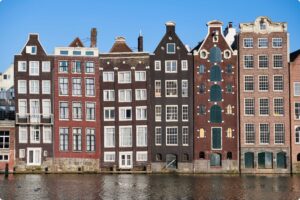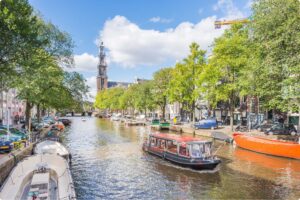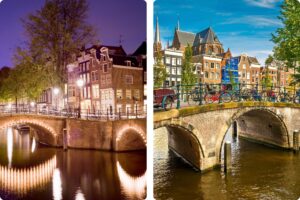Amsterdam is a city full of character, charm, and surprises. While its iconic canals, bicycles, and coffee shops are world-famous, the city also harbors some fascinating and little-known facts. In this blog, we uncover the strangest facts about Amsterdam that might even surprise the locals!
More Bikes Than People
Amsterdam is known as the cycling capital of the world, and for good reason. With over 880,000 bicycles in the city and a population of around 800,000, there are more bikes than residents. That’s an average of 1.1 bikes per person! Amazingly, between 12,000 and 15,000 bicycles are fished out of the canals every year.
Amsterdam’s ‘Dancing’ Houses
Take a stroll along Amsterdam’s canals, and you’ll notice that many houses appear to be leaning or crooked. These so-called ‘dancing houses’ are built on wooden poles that have slowly rotted over the centuries, causing them to tilt. Despite their appearance, these historic buildings remain structurally sound and are a charming part of the city’s character.
The World’s Narrowest Façade
In the heart of Amsterdam, at Oude Hoogstraat 22, stands a building with the narrowest façade in the world—just 1 meter wide! Back in the day, houses were taxed based on the width of their façade, leading to creative architectural solutions. While the building appears tiny from the outside, it becomes slightly wider inside.
The Famous Cat Boat
Did you know Amsterdam has a floating animal shelter dedicated to cats? Known as De Poezenboot (The Cat Boat), this unique houseboat on the Singel canal has been a sanctuary for homeless cats since 1966. It’s now a beloved attraction for cat lovers from around the globe and one of the city’s most unique stops.
A City of Bridges
With over 1,200 bridges, Amsterdam boasts more bridges than Venice. Each bridge has its own charm, and many are illuminated at night, creating a magical atmosphere. It’s a photographer’s dream and an unforgettable sight for visitors exploring the city.
Historic Homes Without Kitchens
Some of Amsterdam’s historic 17th-century homes were built without kitchens. At the time, cooking was considered a fire hazard, especially in wooden houses. Instead, people relied on street vendors and eateries for their meals. Many of these unique homes are still standing, offering a glimpse into Amsterdam’s past.
Narrow Curbs for Bigger Houses
While wandering through Amsterdam, you might notice how narrow the sidewalks can be. This is because homeowners historically prioritized maximizing their living space while minimizing the use of public street space. As a result, pedestrians today often navigate some very slim walkways.
Dancing Was Once Forbidden on Dam Square
Believe it or not, there was a time when dancing was prohibited on Dam Square. In the 1970s and 1980s, strict rules applied to public events in the area, and dancing was not allowed. Thankfully, this quirky rule is now a thing of the past, highlighting how the city has evolved over the years.
Plan Your Perfect Amsterdam Adventure
Amsterdam is a city brimming with history, charm, and fascinating stories. Planning a trip? Don’t miss our blog with the best practical tips for your Amsterdam visit! For a deeper dive into the city, consider taking a self-guided walking tour with SmartWalk Amsterdam. Pause whenever you like and explore the city at your own pace.









